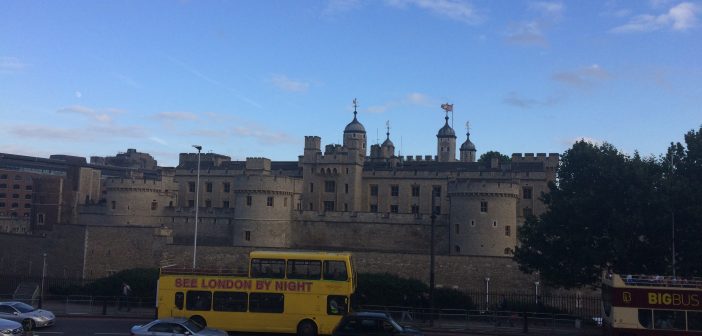Is electric the future? The UK has recently announced its intention to end the sale cars powered by fossil fuels by 2040. The decision follows similar pledges by Norway and France, but highlights the reality of other countries, such as Brazil, who seem to be going in the opposite direction in terms of environmental targets.
The UK seeks to improve air quality, having recently received official warning from the European Union—along with France and Germany—about the region’s pollution levels. The Climate Change Act 2008 demands an 80% reduction in greenhouse gas (GHG) emissions by 2050 (from 1990 levels).

The announcement, made in late July by the UK’s Secretary for Environment, Food and Rural Affairs, Michael Gove, includes hybrid vehicles, those powered by both an electric motor and a combustion engine. By ending the sales of high-combustion motor vehicles, the goal is to reduce emissions by more than 1 billion tonnes a year, worldwide, by 2050. Also in July, Volvo announced that it would only produce fully electric or hybrid cars as of 2019.
Countries such as England, Japan, Germany and the United States are all major consumers and manufacturers of vehicles, and tend to be the trendsetting nations. The expectation is that other governments will sign up to the cause, once the transition to low-emission and electrified transport takes effect in these pioneering countries.
While the UK and other European countries are working towards reducing emissions, the opposite is true in Brazil. Fuelled mostly by financial interests, diesel is still considered suitable for light vehicles. According to Tasso Azevedo, Coordinator of the Greenhouse Gas Emission Estimate System (SEEG), Brazil has the potential to make the change, but instead has chosen to focus on promoting biofuels, and hence neglecting the electric vehicle revolution.
“For example, leaders in Brasilia choose simply to ignore electric vehicles when discussing Brazil’s automotive agenda. Brazil will never bring about change in this area if it depends on the current leadership, but instead will be taken down a path that puts the country’s export capacity first,” he believes.
Whether because of private companies or the government itself, this scenario is unlikely to change in the near future. Big bus manufacturers are not interested in the transition given the lack of market for electric vehicles in the country, which would also pose huge difficulties in terms of selling on the decommissioned fleets. At the same time, the government—the principal shareholder in the country’s leading fuel producer—shows little interest in opening up the competition.
FIGURES
The burning of fossil fuels currently accounts for two-thirds of global emissions of greenhouse gases (GHG), of which transport accounts for 20%. Brazil is the seventh largest global emitter, with transport accounting for 10% of these gases. Zeroing emissions caused by the transport industry around the world, therefore, aims to prevent global warming and to ensure that any rise is reduced to less than 2°C.
According to the latest data, released in 2015 by the UK’s Department of Business, Energy and Industrial Strategy, transport accounted for 24% of GHG emissions, mostly carbon dioxide emissions. The main source of emissions in this sector is the use of gasoline and diesel in road transport.
Carbon dioxide has always been the leading greenhouse gas emitted in the UK. CO2 emissions have decreased considerably since 1990 (principally due to the emission reduction by power plants and residential/industrial combustion).
Whilst road transport, especially passenger cars, is the number one contributor to emissions in the UK, in Brazil it is the freight transportation sector that is most concerning (the use of alcohol to fuel cars already helps offset the emissions of the small vehicle category).
It is important to clarify that air pollution and the emission of gases into the atmosphere are two separate things. Today, pollution is measured using satellite-based technology, and has identified that Africa and Asia have the highest levels, whilst developed countries tend to emit more GHGs.
Paulo Saldiva, a doctor and academic researcher, explains that a lower level of technology in any one country usually correlates to more pollutants in the air. “A New Yorker, for example, on average emits about six times more GHG than someone in São Paulo, but given the efficiency of NYC’s transport system the local effect is smaller (exhausts from a bus, for example).”
 He believes that if everyone was willing to play his or her part—leave the car at home, use less light in the evening, use less water, give up red meat—in 80 years time we would start to see GHG emissions fall. “The same thing that emits GHG into the global environment, however, also produces, to a greater or lesser extent, local damages, which can be converted into two currencies: loss of life or a loss in the number of productive years of life,” he explains.
He believes that if everyone was willing to play his or her part—leave the car at home, use less light in the evening, use less water, give up red meat—in 80 years time we would start to see GHG emissions fall. “The same thing that emits GHG into the global environment, however, also produces, to a greater or lesser extent, local damages, which can be converted into two currencies: loss of life or a loss in the number of productive years of life,” he explains.
HEALTH
In addition to the environmental question, air pollution also poses a threat to human health, as recognised by the World Health Organization. It is estimated that three million people worldwide die prematurely each year due to air pollution. In the UK, it accounts for 40,000 premature deaths. The associated impacts of pollution on our health are tantamount to those caused by cigarettes: myocardial infarction, stroke, pneumonia, and miscarriages.
In Brazil, the records for São Paulo and Rio de Janeiro show a less-than-ideal history of air pollution, despite the recent figures that indicate that there has been a significant decrease. Each year in São Paulo pollution claims the lives of 4,500 people in the city, 7,500 in the greater metropolitan area, and 15,000 across the entire state.
According to Paulo Saldiva, every two hours in São Paulo traffic has the detrimental effect of smoking a cigarette as even though there have been technological advancements in fuel production, traffic has become exponentially slower and, therefore, the individual is exposed to pollutants for longer periods of time.
The reduction in the use of vehicles and fossil fuels would also, naturally, encourage people to use bicycles or walk, so would therefore have a positive influence on the overall health of a nation. “The person would become a true pedestrian and walk more, leading to a significant drop in the risks of mental illness, heart disease and osteoporosis, as well as controlling the onset of diabetes and high blood pressure,” says Saldiva.
He believes that everyone has a different level of tolerance when it comes to pollutants. “Some people’s tolerance may be so low that they are in fact harmed by the levels of pollution deemed acceptable by legislative authorities. Each body is different; each one of us has our own safety limit. It is like smoking and living with smokers,” he explains.
He also says that there is no “bearable” amount of pollution: the less the better. However, taking the romantic view that levels can be returned to zero one day is pure fantasy; there are innumerable natural processes that contribute to overall pollution.
BACKGROUND
Reports of low air quality in London date back to the Middle Ages. Even in classic movies, the cityscape is always shrouded in fog and smoke. On 5th December, 1952, the reputation of the English capital was tarnished. Literally. A dense fog of pollution—which claimed more than 10,000 lives—wreaked havoc and caused widespread panic amongst London’s citizens and authorities.
Known as the Great Smog of London, the phenomenon was little cause for alarm at first, since London was already infamous for having periods of mischievous fog. However, the stench, the colour of the air and the low visibility drove the population to the brink, for five long days.
When the fog dissipated on 9th December, London, the capital of the world at the time, was faced with a shocking death toll. It is estimated that 12,000 men, women and children lost their lives over a two-week stretch of elevated pollution.
The solution to the problem is far from simple. As there is no means of air treatment (like there is with water and sewage, for example), the only option is preventative: to minimalize pollution. Following the tragedy of 1952, a law designed to regulate pollution was passed.
For more information on emissions in Sao Paulo, in real time, visit:
http://emissoes.energiaeambiente.org.br/ and http://qualidadedoar.org.br/

















